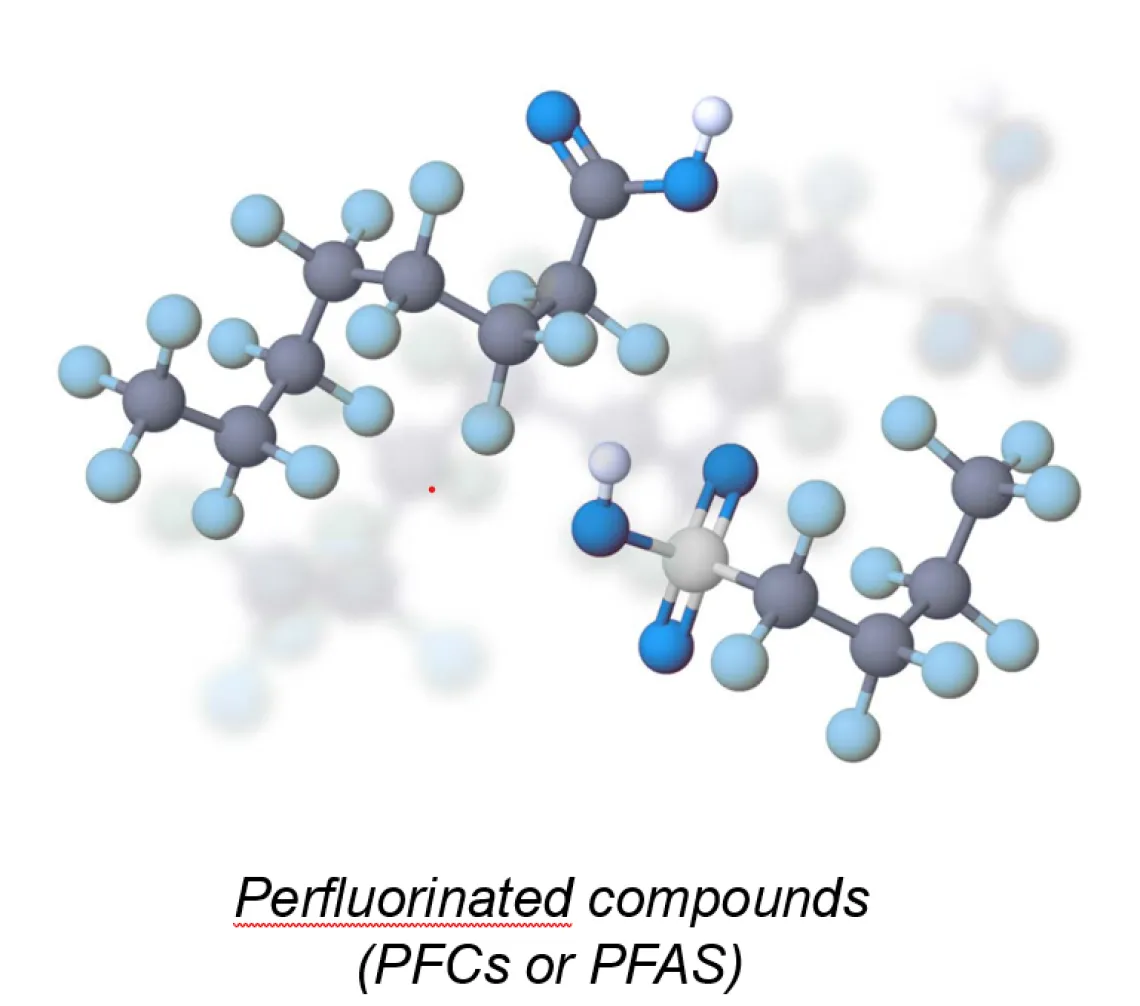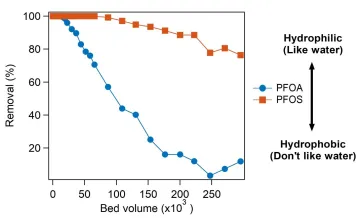Understanding Per- and Polyfluoroalkyl Substances and their Impacts

Understanding Per- and Polyfluoroalkyl Substances in Water
Per- and polyfluoroalkyl substances (PFAS) have been in the news often lately. Here’s what you need to know.
PFAS are a group of organic compounds used in commercial and industrial applications. They can be found in many items such as non-stick cookware, furniture, and firefighting foam, as they are water, heat, and grease resistant (NIEHS, 2019). The use of PFAS in firefighting foam, while useful, has contributed to widespread environmental contamination (Houtz et al., 2013). Due to their chemical structure, these compounds break down slowly in the environment, and can easily migrate through soil and water (CDC, 2017). Because of this, PFAS are found everywhere throughout the world. Trace levels of PFAS have been found in water, soil, plants, animals, and people in both urban and remote locations. (ASTSWMO, 2015).
Two of the most widely produced and studied PFAS are Perfluorooctanoic Acid (PFOA) and Perfluorooctane Sulfonate (PFOS) (EPA, 2018). Though PFAS are prevalent worldwide, the overall levels of PFOA and PFOS are on the decline, due to discontinuing production in the US. PFOS was voluntarily phased out by 2002, and a number of major companies agreed to cease producing PFOA in 2006 (EPA, 2018). Detection of PFAS in water sources across the country has raised health and safety concerns. “Because these substances do not break down easily, it is estimated that PFAS can persist in the human body for up to 4 to 8 years. While that may seem like a long time, exposure does not necessarily mean that a person will get sick, however the long-term effects on people are still being investigated (NIH, 2016a).” Laboratory studies wherein animals were given large amounts of PFAS found that PFAS may cause reproductive, developmental, and thyroid issues, as well as have adverse effects on the liver and pancreas (CDC, 2017). More research is needed to determine the impacts of PFAS exposure.
The EPA has a lifetime health advisory level set at 70 parts per trillion for PFOA and PFOS combined (EPA, 2016). A part per trillion, or ppt, is about one drop of water in 1,000 Olympic-size swimming pools (EWG, 2017). This EPA limit is non-enforceable and serves as a recommendation for when further testing and treatment should take place. However, the EPA is beginning to develop an action plan for managing and regulating PFAS, to be proposed by the end of the year (StateImpact Pennsylvania, 2019). In the meantime, other states, such as California and New Jersey, have begun implementing stricter regulations. California has set 14 ppt for PFOA and 13 ppt for PFOS as “notification levels” for when the water sources need to be serviced and treated (State Water Resources Control Board, 2018).

<Figure 1> Removal of PFAS spiked in groundwater with respect to bed volume (i.e. ratio of total amount of water filtered versus the filter bed volume). About 300 ng/L of PFAS were spiked into a tap water to simulate a scenario of groundwater contamination.
WEST Center has analyzed trace levels of PFAS in waters and evaluated treatment technologies such as activated carbon adsorption. PFAS attenuation largely depends on their physical characteristics. For instance, PFOS is more hydrophobic (i.e. does not like water) than PFOA, therefore is more effectively retained by activated carbon adsorption (Figure 1). As more water is filtered, activated carbons gradually become exhausted and lose adsorption capacity. WEST Center is currently making efforts to develop a predictive model for PFAS adsorption in activated carbon adsorption and to assess other treatment technologies such as anion-exchange resins.
Sources:
Association of State and Territorial Solid Waste Management Officials (ASTSWMO), Remediation and Reuse Focus Group Federal Facilities Research Center, 2015.
Perfluorinated Chemicals (PFASs): Perfluorooctanoic Acid (PFOA) & Perfluorooctane Sulfonate (PFOS), Information Paper. https://clu-in.org/download/contaminantfocus/pops/POPs-ASTSWMO-PFASs-20…
Houtz, E.F., Sedlak, D.L, 2012. Oxidative conversion as a means of detecting precursors of perfluoroalkyl acids in urban runoff. Environ. Sci. Technol. 46(17), 9342-9349.
Hurdle, Jon, and Susan Phillips. “EPA Says It Will Start Process to Regulate PFOA and PFOS This Year | StateImpact Pennsylvania.” StateImpact Pennsylvania, NPR, 14 Feb. 2019, https://stateimpact.npr.org/pennsylvania/2019/02/14/epa-says-it-will-be….
National Institutes of Health (NIH), National Institute of Environmental Health Services, 2016a. Perfluorinated Chemicals (PFASs). Website. Accessed October 2, 2018. https://www.niehs.nih.gov/health/topics/agents/PFAS/index.cfm.
“Per- and Polyfluorinated Substances (PFAS) Factsheet.” National Biomonitoring Program, Centers for Disease Control and Prevention, 7 Apr. 2017, www.cdc.gov/biomonitoring/PFAS_FactSheet.html.
“PFAS - Per- and Polyfluoroalkyl Substances.” National Institute of Environmental Health Sciences, U.S. Department of Health and Human Services, 27 Feb. 2019, www.niehs.nih.gov/health/topics/agents/pfc/index.cfm.
“PFOA and PFOS Drinking Water Health Advisories.” Environmental Protection Agency, Nov. 2016, www.epa.gov/sites/production/files/2016-06/documents/drinkingwaterhealthadvisories_pfoa_pfos_updated_5.31.16.pdf.
State Water Resources Control Board. “Groundwater Information Sheet.” California Water Boards, 14 Dec. 2018, www.waterboards.ca.gov/water_issues/programs/gama/docs/pfoa.pdf.
Walker, Bill, and Soren Rundquist. “PFCs: A Water Contamination Crisis.” Mapping a Contamination Crisis, Environmental Working Group, 8 June 2917, www.ewg.org/research/mapping-contamination-crisis.

